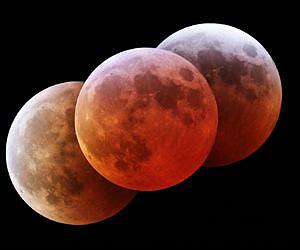Get set for an amazing adventure. The eclipse will be visible over more than half the globe, throughout most of South America, Europe, Africa, and Asia, the Indian subcontinent and Australia.
 It's expected to be one of the darkest eclipses on record, due to an unusually straight alignment between Sun, Moon and Earth. In fact, predictions are the Moon will turn a blood red colour at totality!
It's expected to be one of the darkest eclipses on record, due to an unusually straight alignment between Sun, Moon and Earth. In fact, predictions are the Moon will turn a blood red colour at totality!
The eclipsed Moon can often appear a coppery colour at totality due to sunlight being refracted by the Earth's atmosphere, but airborne ash from the recent eruptions of volcanoes in Iceland and existing airborne pollution will add to the darkening effect.
"Lunar eclipses are one of the most spectacular sights in astronomy and one not to be missed," said well known Australian astronomer, David Reneke, writer and publicist for Australasian Science magazine. Lunar eclipses occur when Earth gets between the sun and the moon, casting a shadow.
"We'll get a good view across Australia," David said.
"The Moon will start to move into the Earth's core shadow at 4.23am Eastern Standard Time and totality begins an hour later, at 5.22am with the Moon fully immersed in the earth's shadow. This is when you get the spectacular reddish colour so put your camera onto a tripod and take a photo." David is an astronomy writer, lecturer and teacher and a featured guest on over a dozen ABC and commercial radio stations each week across Australia.
The Astronomical Research Center (A.R.C) mentioned that as the eclipse progresses, the Moon's disc will take on an eerie coppery red glow. This is because sunlight falling on the Moon has been filtered through the earth's atmosphere. The exact appearance depends on how much dust and clouds are present in the upper atmosphere at the time.
"Astronauts on the Moon would see an amazing sight," David said. "They'd actually see the Earth eclipsing the Sun! They would see a bright red ring around the Earth as they watched all the sunrises and sunsets happening simultaneously around the world."
David said that unlike solar eclipses, lunar eclipses are completely safe to watch. You don't need any kind of protective filters. You can watch the lunar eclipse with nothing more than your own two eyes.